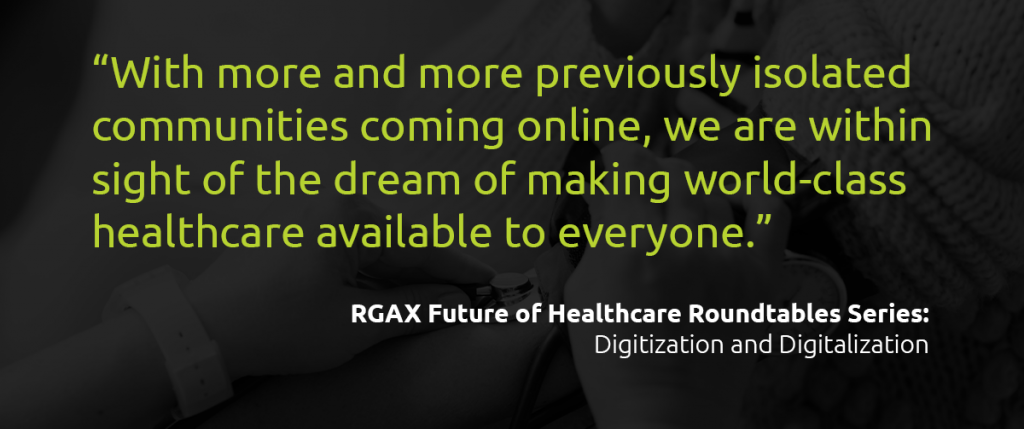The Future of Healthcare: Overcoming Obstacles to Digitalization
“Sometimes, the position carriers hold between physician and patient can be an uncomfortable one, but in this case, it gives them a unique vantage point from which they can design purpose-built solutions that appeal to both provider and patient.”
To help carriers keep up with advancements in insurtech and prepare for the future of healthcare, RGAX is conducting a series of roundtables with experts in technology and insurtech solutions. Our digital health roundtable discussion was hosted by Dr. James Somauroo, founder of somX. James was joined by Stephen Bourke, co-founder of Echo, an online pharmacy, and Emmanuel Djengue, Innovations Director at RGAX.
Part one of my recap of this discussion focused on how the roundtable team differentiated between digitization and digitalization in healthcare and insurtech. James, Stephen, and Emmanuel did an excellent job discussing the differences and highlighting why digitalization will be necessary for the healthcare and insurtech industries to reach their goals. You can read my recap here.
In this post, I’ll dive deeper into the second half of the conversation, where the group discussed the many obstacles the industries will need to overcome to achieve their goals, and how carriers can be a catalyst for change. But before we get to that, let’s start with a very important question James posed to the team:
Should We Digitalize All Aspects of Healthcare?
In response to James’ question, Stephen noted that if 2020 has proven anything, it is that we may need to digitalize everything, or at least as much as we can. Due to the pandemic, remote access to healthcare services became more important than any of us could have imagined. COVID-19 has showed us where we needed to be and set the industry on an accelerated path.
That said, the roundtable went on to discuss the real benefits of digitalized healthcare and how this impacts life insurance. Emmanuel succinctly called out three primary advantages:
- Transparency – Our industry has always wrestled with a disconnect between patient and provider. Patients may be so overwhelmed when talking with their doctors that they forget half of what gets said. If the visit is recorded, they can replay it and capture what they missed. For parts of the consultation they didn’t quite understand, they can research terms the doctor used and connect through online care management services to ask follow-up questions.
- Agility and Efficiency – As populations age and people live longer, the ability to serve more patients per provider is going to be increasingly necessary. Improving access to services will also place more demand on systems and providers. Digitalization of healthcare can help make providers more efficient so they can deliver more services to more patients.
While that sounds good for the provider, what about the patients? As Emmanuel pointed out, patients benefit as well. For example, they don’t have to leave their home or office and drive 30 minutes or more to the doctor’s office only to sit another 45 minutes in the waiting room. If a provider is able to see more people, individuals needing to see a doctor for routine or low-level concerns might not have to wait as long for an appointment either.
- Accessibility – In the past, rural communities have had to be content with the town doctor, no matter the skill level or personality. Remote areas were lucky to have a doctor come through once a month. With more previously isolated communities coming online, we are within sight of the dream of making world-class healthcare available to everyone.

What Will It Take to Make Change Happen?
As technologists, it seems James, Stephen, and Emmanuel share a frustration that change isn’t happening faster. They see the good that technology can do, like equalizing access to world-class healthcare and fostering healthier lifestyles. While where we are today is a positive start, we are nowhere near where we need to be.
Stephen brought up some of the challenges of providing digitalized healthcare services compared to other types of products. According to his research, the penetration of online pharmacies in the U.K. is 2.5%, whereas online banking is 73%. Banks are incentivized to bring people online, and they have managed to be astoundingly successful to the point where even older people are banking remotely. But the “great limiting factor” in healthcare is its very nature. We have not managed to effectively or consistently replicate those soft moments – that hand on the shoulder or the quiet of the room as the doctor listens to their patient for an extra minute or two – in the digital experience.
Two things need to happen for digitalization to take off. First, customers need to mandate it. James brought up that demanding digitalized solutions can be particularly powerful in countries with a private healthcare system. If one provider is not offering patients with the services they want, they can take their business to another provider. But even in a public healthcare system, asking for digitalized services can help drive progress, though perhaps a bit more slowly.
“The first persons that need to drive this adoption and change are the patients and their families. They should be ready and willing, and they need to demand this digitalization.”
Emmanuel Djengue, Innovations Director at RGAX
That brings up the second thing that needs to happen for digitalization to take off in healthcare: Legislators need to clear the way. Sometimes, clearing the way for digitalization in healthcare may mean passing legislation that promotes digital healthcare, but as often as not, it means getting rid of older legislation designed for a less digitalized society.
“When we look at the European Union, [a single market] exists in every sector apart from health. There is no single market within health.”
Stephen Bourke, Co-founder of Echo
Carriers are the Catalyst
The focus of this roundtable discussion on the future of healthcare largely centered around patient and provider, but it was clear that carriers can also be the catalyst for change. Sometimes, the position carriers hold between physician and patient can be an uncomfortable one, but in this case, it gives them a unique vantage point from which they can design purpose-built solutions that appeal to both provider and patient.
In many parts of the world, carriers are no stranger to the political process either. They can continue to lobby and work with legislators so those who make the laws understand the importance of technology and their role in driving change. In the end, real, lasting change will require a concerted effort on the part of many constituents, but if we work together, we can make it happen.
👂 Listen to Future of Healthcare Roundtables Series: Digitization and Digitalization, Episode 2 of 2

